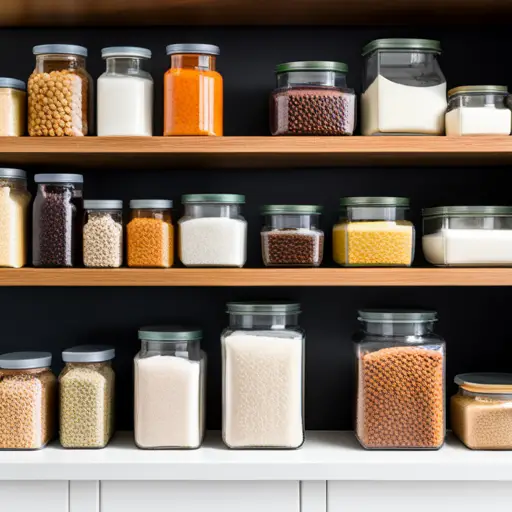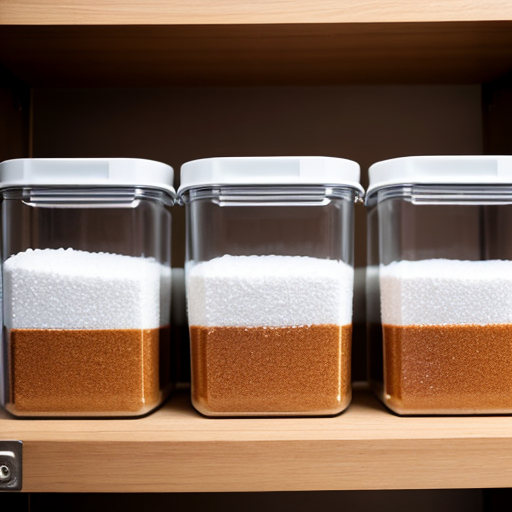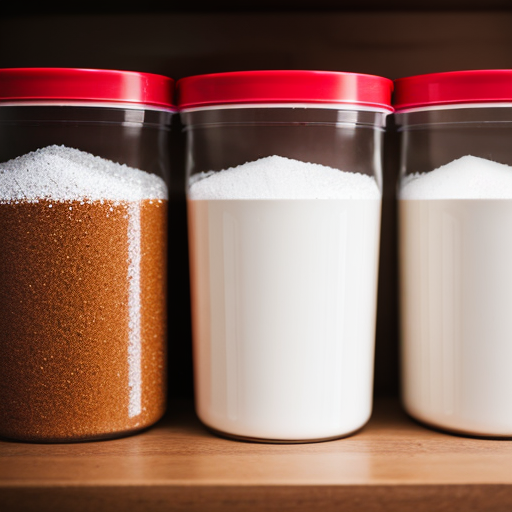
Sugar is a staple ingredient in many households for baking, cooking, and sweetening beverages. Properly storing sugar in the pantry ensures its freshness and quality for extended periods. In this comprehensive guide, we will explore various methods and tips on how to store sugar in the pantry effectively. Whether you have granulated sugar, brown sugar, or powdered sugar, these storage techniques will help you maintain the flavor and texture of your sugar for all your culinary endeavors.
How to Store Sugar in the Pantry?
Sugar storage requires attention to environmental factors such as moisture, heat, and exposure to air. By following these guidelines, you can keep your sugar fresh and prevent clumping or hardening:
Choose the Right Container
To store sugar properly, it is essential to select the right container. Opt for an airtight container that can effectively seal out moisture and air. Glass or food-grade plastic containers with tight-fitting lids are ideal for this purpose. Avoid using containers made of materials that can transfer odors to sugar, such as cardboard or metal.
Keep It in a Cool and Dry Place
Sugar is sensitive to heat and moisture, so storing it in a cool and dry place is crucial. The pantry is ideal if it is away from direct sunlight, stoves, and other heat sources. High temperatures can cause the sugar to clump or harden, compromising its quality and texture.
Avoid Exposure to Air
Exposure to air can lead to the absorption of moisture and result in clumpy or hardened sugar. Always seal the container tightly to prevent air from entering. Additionally, consider using smaller containers to minimize the surface area exposed to air each time you open the container.
Use Moisture Absorbers
You can place moisture absorbers in the storage container to further protect your sugar from moisture. Silica gel packets or food-grade desiccant packs are excellent options. These absorbent materials help maintain the dryness of the sugar, preventing clumping or moisture-related issues.
Store Away from Strong Odors
Sugar has a tendency to absorb odors, so it’s essential to keep it away from strong-smelling substances. Avoid storing sugar near spices, herbs, or aromatic ingredients that could taint its flavor. This precaution ensures that your sugar maintains its original taste and aroma.
Label and Date the Container
To keep track of your sugar and ensure its freshness, it’s advisable to label the container with the type of sugar and the date of storage. This simple step helps you identify different sugars at a glance and ensures you use the oldest ones first, maintaining a rotation system.
Avoid Freezer Storage
While freezing sugar is technically possible, it is not recommended. Freezing can cause condensation when the sugar is returned to room temperature, leading to clumping and deterioration of quality. Therefore, it is best to avoid freezing sugar and opt for pantry storage instead.
Use Brown Sugar Bear or Terra Cotta Discs

For those who frequently use brown sugar, a Brown Sugar Bear or terra cotta disc can be a useful addition to the storage container. These products help retain moisture and prevent brown sugar from drying out and hardening. Soak the Brown Sugar Bear or terra cotta disc in water and place it in the sugar container for optimal results.
Check for Pests Regularly
Pests like ants or weevils can infiltrate your pantry and enter your sugar. Regularly inspect your sugar container for any signs of infestation. If you notice pests, dispose of the affected sugar and take measures to eliminate the pests from your pantry.
Use a Dry Spoon or Scoop
Using a clean, dry spoon or scoop is important when scooping sugar from the storage container. Moisture from utensils can introduce moisture into the sugar, causing clumping or hardening over time. By using a dry utensil, you can maintain the integrity of the sugar and ensure its freshness.
Different Uses of Sugar
Sugar, primarily derived from sugarcane and sugar beet, has been used for centuries not only for its sweetness but also for a variety of other purposes. Here are some of its primary uses:
1. Food and Beverages
- Sweetening: The primary use of sugar is to sweeten foods and drinks, from baked goods to beverages.
- Preservation: In jams, jellies, and preserves, sugar acts as a preservative by binding to water, thereby inhibiting the growth of microorganisms.
- Fermentation: In baking, sugar feeds yeast, leading to fermentation which helps dough rise. It’s also essential in alcohol fermentation for products like wine and beer.
- Texture and Structure: In baking, sugar can provide structure to cakes, softness to cookies, and a crispy crust to pastries.
- Caramelization: Sugar, when heated, can brown and develop a complex flavor, a process used in various culinary dishes.
- Freezing Point Depression: Sugar lowers the freezing point in frozen desserts like ice cream, ensuring a smoother texture.
2. Medicine
- Syrups: Sugar is used in medicine to create syrups that can mask the unpleasant taste of some drugs.
- Healing: Historically, sugar has been applied to wounds to reduce the risk of infection. This is because sugar can draw water out of bacterial cells, inhibiting their growth.
3. Cosmetics
- Exfoliation: Due to its grainy texture, sugar is a common ingredient in exfoliating body and face scrubs.
- Humectant: Sugar can attract moisture from the environment, making it useful in cosmetics as a moisturizer.
4. Industrial Uses
- Leather Tanning: Sugar can be used in certain leather tanning processes.
- Biofuel Production: Some processes convert sugarcane into ethanol, a biofuel.
5. Crafts and Hobbies
- Decoupage: Sugar water can be used as an adhesive in certain crafting scenarios.
- Rock Candy: Growing sugar crystals on strings or sticks as a fun experiment and treat.
6. Other Uses
- Flower Preservation: Sugar can be added to water to extend the life of cut flowers.
- Cleaning Agent: A sugar and water paste can be used to clean grinders and other kitchen equipment, especially when removing the strong scent of spices.
- Pest Trap: Sugar can be used as bait in certain pest traps, particularly for insects like ants.
While sugar’s most widespread use is in the culinary world, its properties make it versatile across various fields and applications. However, it’s worth noting that excessive sugar consumption is linked to various health concerns, so it’s essential to consume it in moderation when it comes to dietary intake.
Benefits of storing sugar properly
Storing sugar properly is essential for several reasons, both culinary and practical. Here are the benefits of ensuring sugar is correctly stored:
1. Longevity
- Proper storage can extend the shelf life of sugar. While sugar doesn’t spoil like many other foods might, moisture and contaminants can compromise its quality.
2. Retain Granular Structure
- Keeping sugar in a dry environment prevents it from clumping together or hardening. This is especially crucial for brown sugar, which tends to harden if exposed to air for extended periods.
3. Prevent Contamination
- Sealed containers ensure that contaminants, such as dust or other foreign particles, are not mixed in. They also ensure the sugar remains free of odors from surrounding items.
4. Pests Control
- Proper storage keeps pests like ants, cockroaches, and rodents at bay. Sugar is a significant attractant for many pests, and it can be hard to eliminate once they find a source.
5. Preservation of Flavor
- Sugar can absorb flavors and odors from its surroundings. Proper storage ensures that it retains its pure, sweet taste without any unintended flavors.
6. Ease of Use
- Sugar that is free from clumps and contaminants is easier to measure and use in recipes. Consistent texture ensures you get the expected results, especially in baking, where precise measurements are vital.
7. Economic Benefits
- Properly stored sugar lasts longer, reducing waste and the need for frequent replacement. This can save money in the long run.
8. Safety
- Keeping sugar in a clean, sealed container reduces the risk of it becoming a breeding ground for any microscopic organisms that thrive in sugary environments.
9. Aesthetic and Organization
- Storing sugar in designated containers can contribute to a tidy and organized kitchen or pantry, making it easier to locate and use when needed.
10. Maintain Nutritional Value
- Proper storage for sugars that contain molasses, like brown sugar or raw sugar, ensures that the nutritional content remains intact, though minor.
While sugar itself is a relatively stable product, storing it correctly is crucial to maintain its quality, extend its shelf life, and ensure the best outcomes in culinary endeavors.

The best container to store sugar
- Glass containers with airtight seals are non-porous, meaning they don’t absorb smells or flavors, ensuring the sugar remains uncontaminated.
- Plastic food-safe containers with a tight-sealing lid: These are lighter than glass and can also be effective if they provide an airtight seal.
- Stainless steel canisters are durable and won’t react with sugar.
How to store sugar to prevent bugs
- Always keep sugar in a sealed container.
- Ensure your storage area is clean, dry, and free from any food residue that might attract pests.
- Regularly inspect your pantry for signs of bugs or infestations and address any issues promptly.
- Store sugar off the ground, ideally on a shelf.
How to store sugar for long term?
- Use vacuum-sealed bags or containers.
- Store in a location away from direct sunlight, in a cool and dry place.
- Ensure it’s protected from pests and contaminants.
How do you store sugar for 25 years?
- White sugar has an indefinite shelf life if kept in the right conditions, so focus on optimal storage.
- Vacuum seal the sugar in mylar bags with oxygen absorbers.
- Place these bags in a food-grade bucket with a tight-sealing lid.
- Store in a cool, dry, and dark place.
Best containers to store flour and sugar?
- Glass jars with airtight seals: Ideal for both.
- Food-grade plastic containers with tight-sealing lids: These are suitable, especially if they’re transparent so that you can see the contents.
- Mylar bags: Especially if you’re considering long-term storage.
Can you store sugar in the refrigerator?
- It’s not necessary. Sugar is best stored in a cool, dry place. Storing sugar in the fridge might introduce moisture which could cause the sugar to clump.
How to store sugar in mylar bags?
- Fill: Pour the sugar into the mylar bag, leaving a few inches from the top for sealing.
- Oxygen Absorbers: Add an appropriate-sized oxygen absorber to the bag. This will help remove any remaining oxygen from the bag once sealed.
- Seal: Use a heat sealer or a hot iron to seal the mylar bag. Ensure you have a smooth and complete seal to ensure no air can get in.
- Label and Date: Always label the content and the date of storage.
- Protection: Once sealed, you can place the mylar bags in a food-grade bucket or container for added protection against pests and physical damage.
By following these guidelines, you can ensure the quality and longevity of your stored sugar. Remember, keeping your sugar (and flour) in an environment free from moisture, pests, and contaminants is crucial.
FAQs
Does sugar go bad if stored for a long time?
Sugar does not spoil, but improper storage can cause it to clump, harden, or develop off-flavors. With the right storage methods, you can keep sugar fresh for an extended period, maintaining its quality and taste.
Can I store sugar in the refrigerator?
A: Refrigerator storage is not recommended for sugar, as it can absorb moisture and develop clumps. It’s best to store sugar in an airtight container in a cool, dry pantry.
How long can sugar be stored in the pantry?
Properly stored sugar can remain fresh in the pantry for an indefinite period. However, using it within two years is advisable for optimal flavor and quality.
What are the signs of spoiled sugar?
Spoiled sugar may exhibit signs of mold, an unusual odor, or an off-taste. If you notice any of these signs, it’s best to discard the sugar and replace it with fresh supplies.
Can I store different types of sugar together?
It’s generally safe to store different types of sugar together as long as they are in separate airtight containers. This prevents cross-contamination and maintains each sugar variety’s flavors and textures.
Are there any alternatives to traditional sugar storage methods?
If you prefer alternative storage methods, you can consider using vacuum-sealed bags, airtight jars, or canisters with sealing mechanisms to store sugar effectively.
Conclusion
Properly storing sugar in the pantry is essential for maintaining its freshness, flavor, and quality. By following the guidelines mentioned above, you can ensure that your sugar remains clump-free, easy to use, and suitable for all your culinary needs. Remember to choose the right container, store it in a cool and dry place, avoid exposure to air, and periodically check for pests. With these simple steps, you can enjoy fresh sugar whenever needed.
